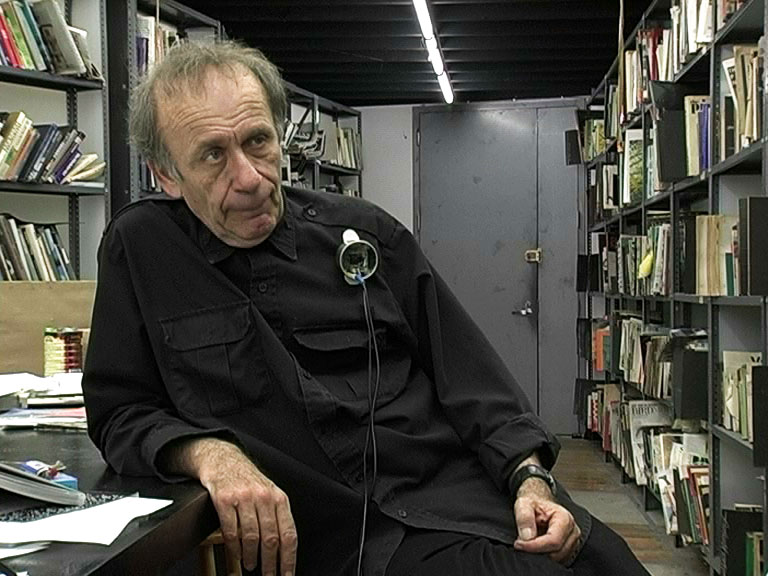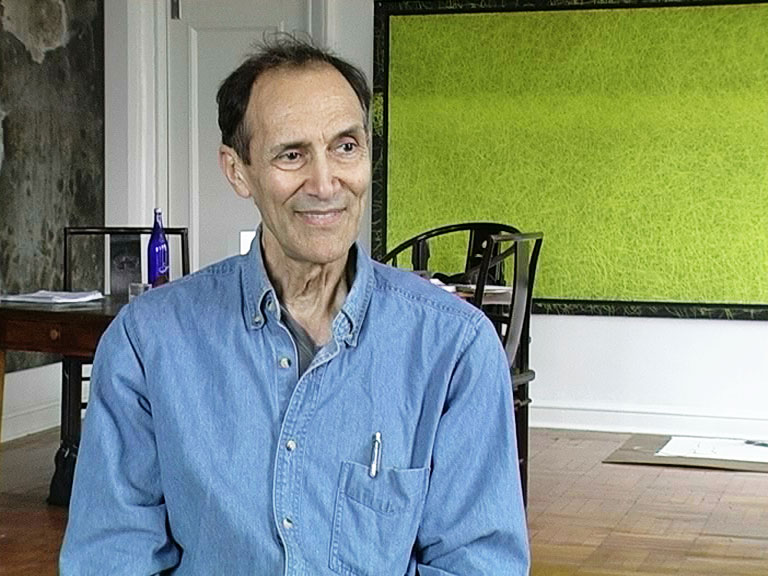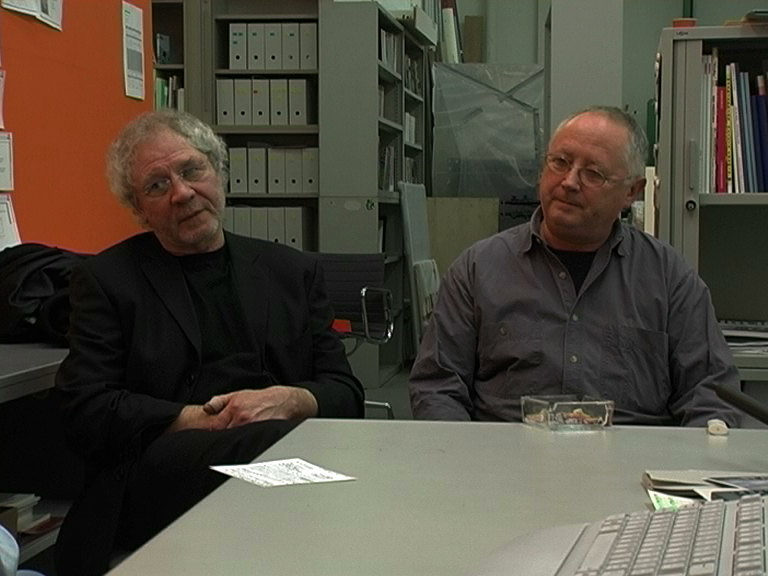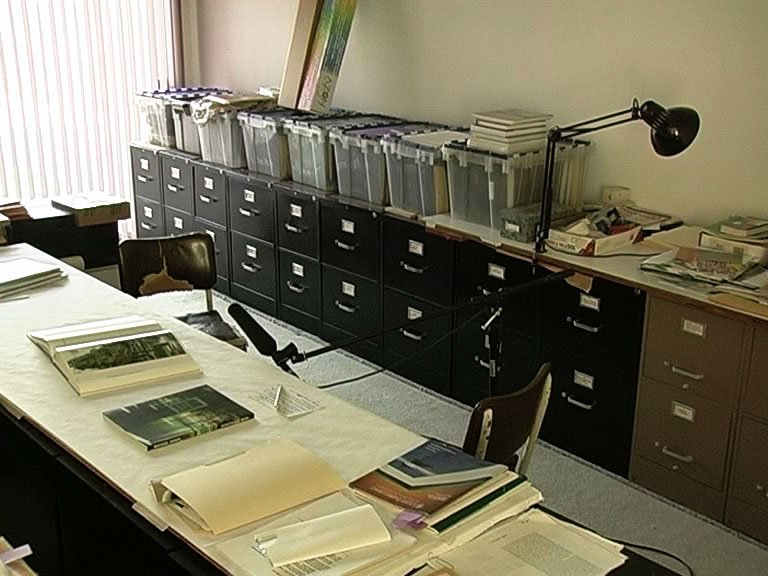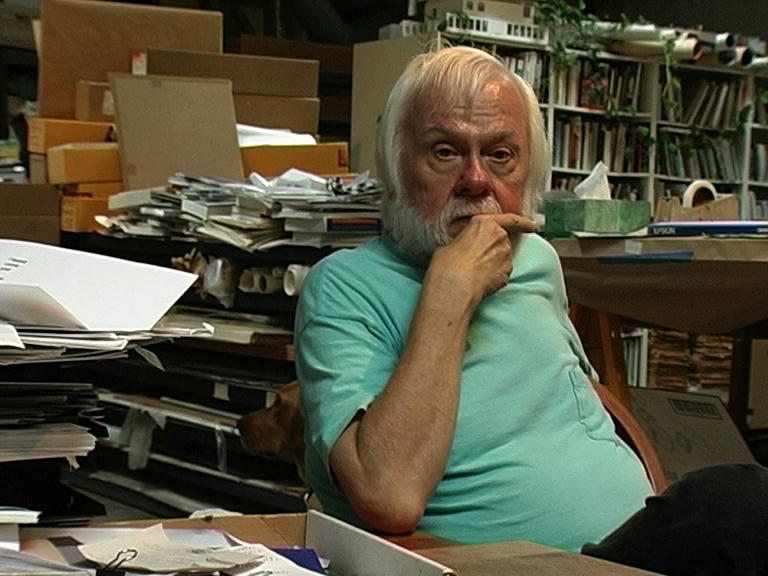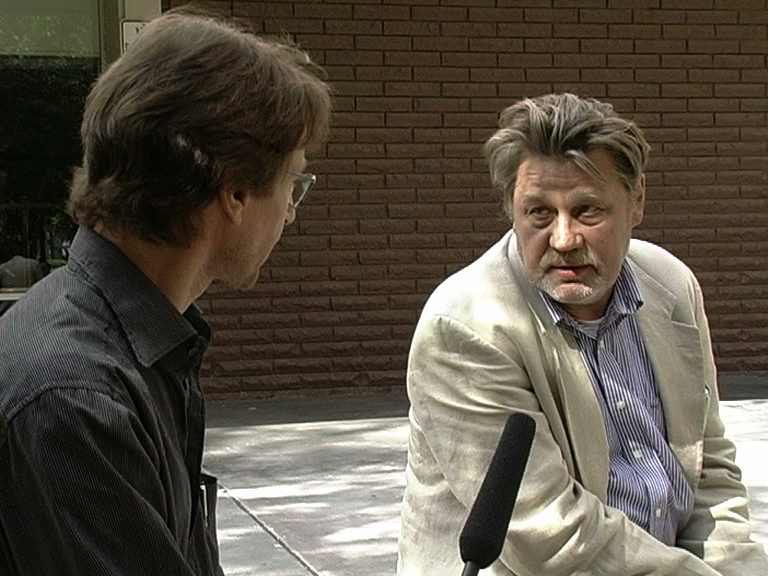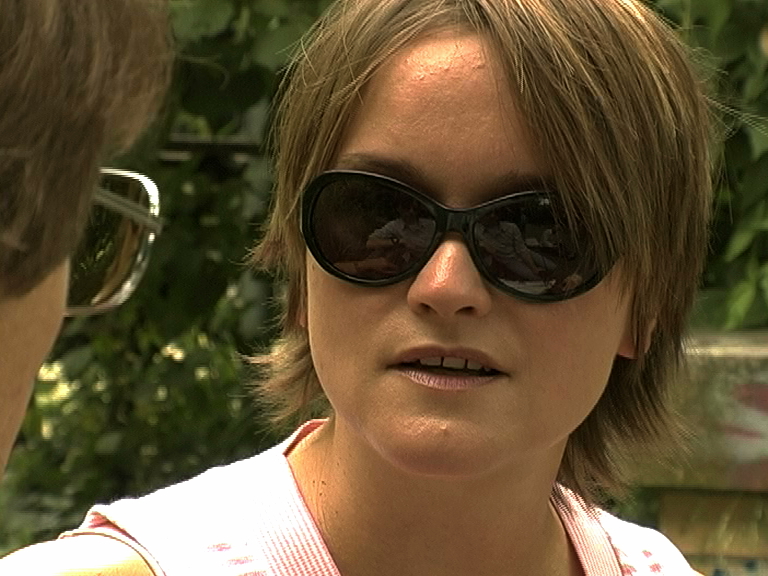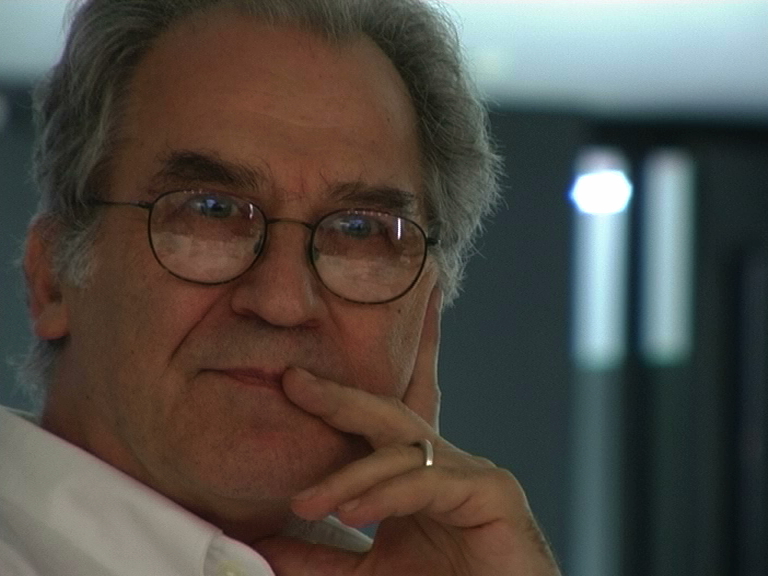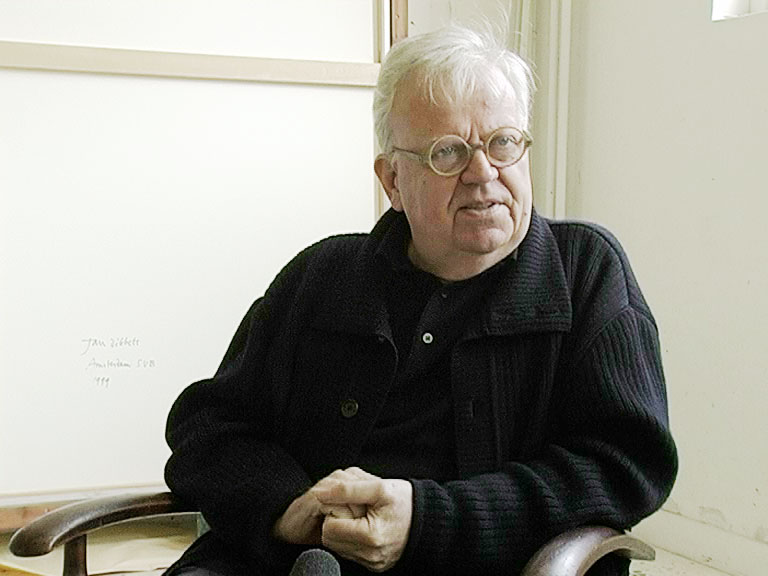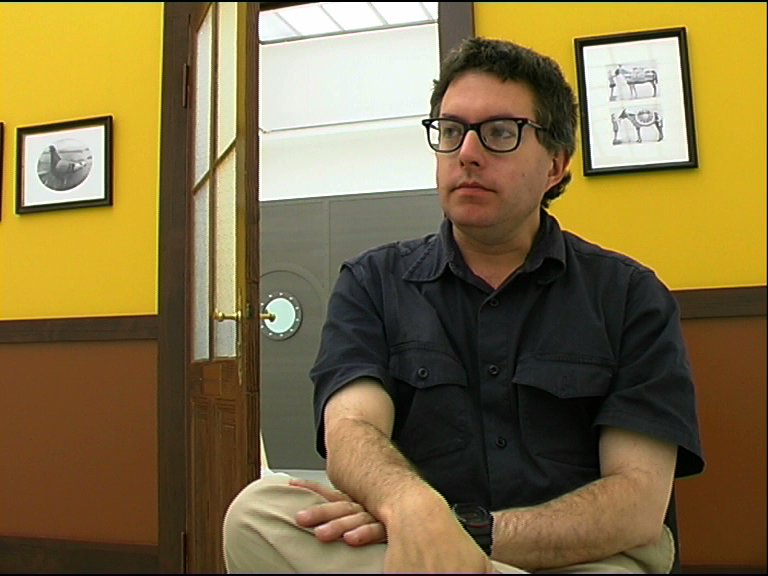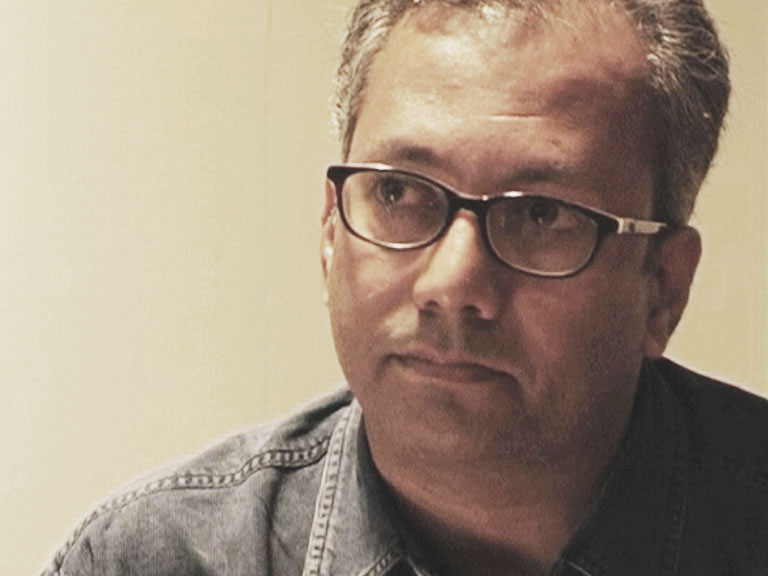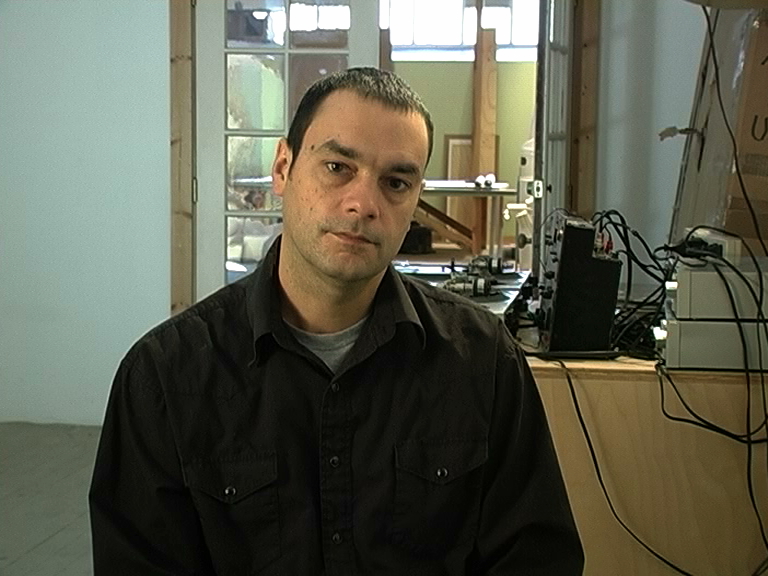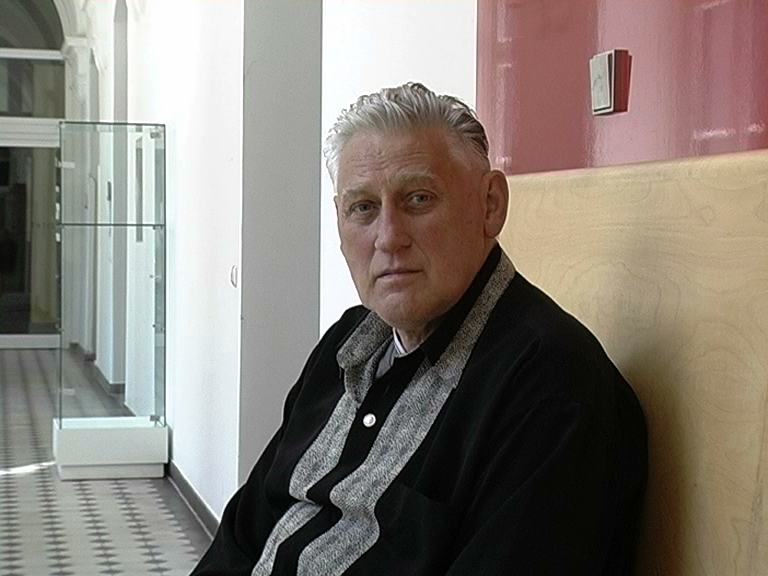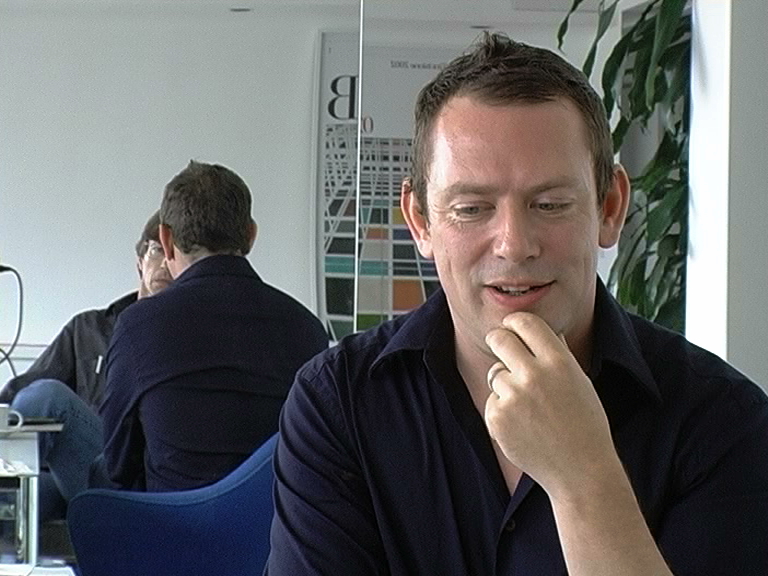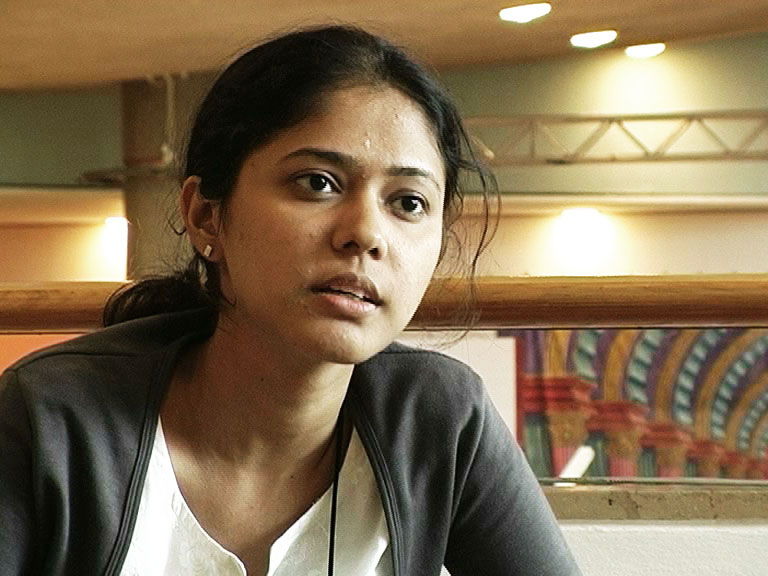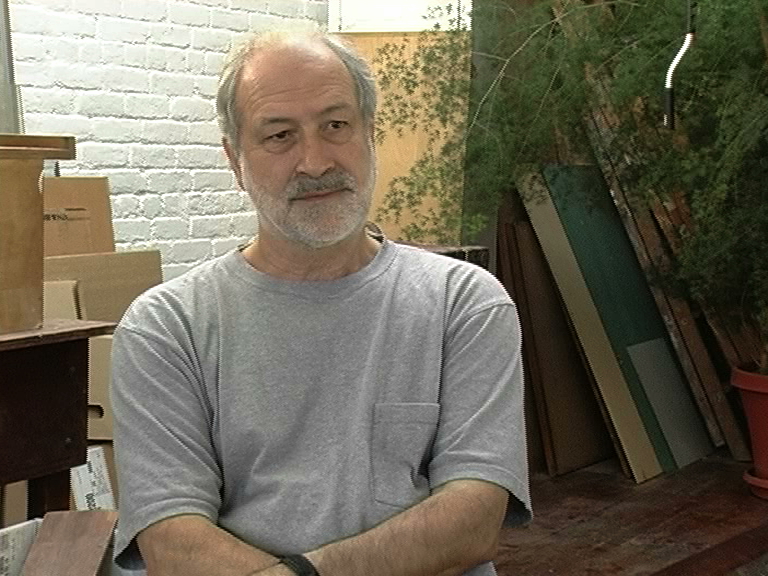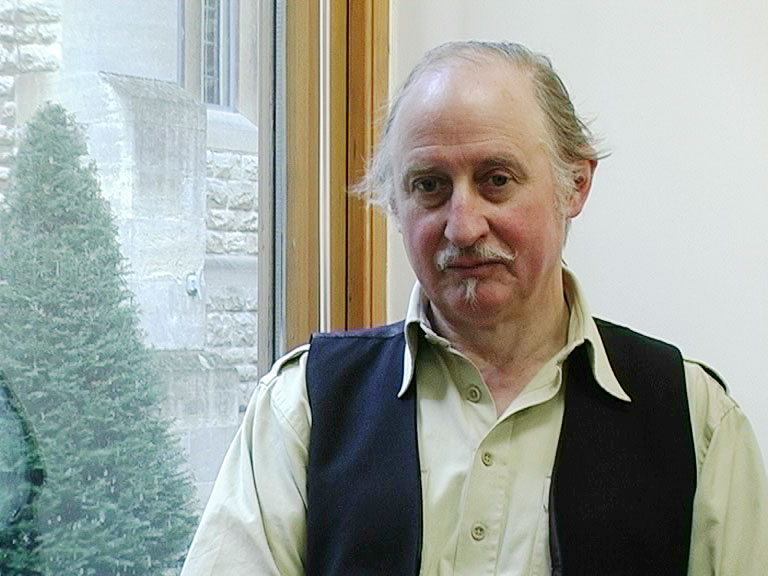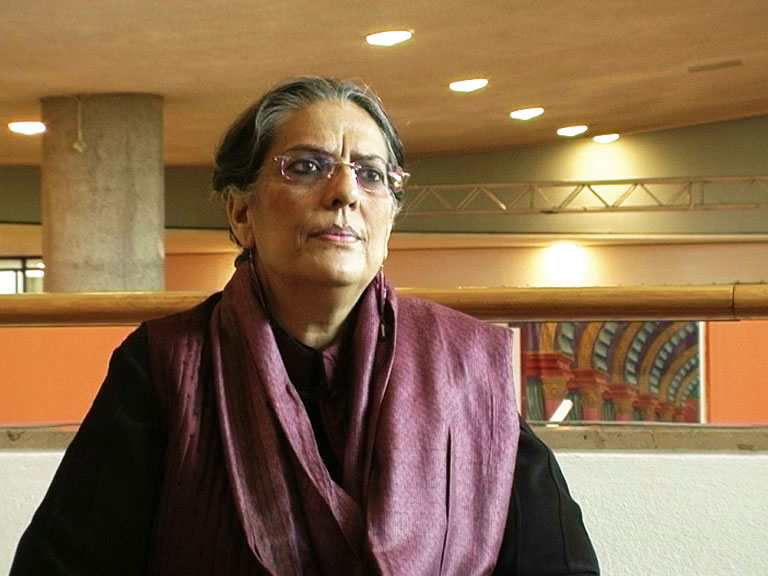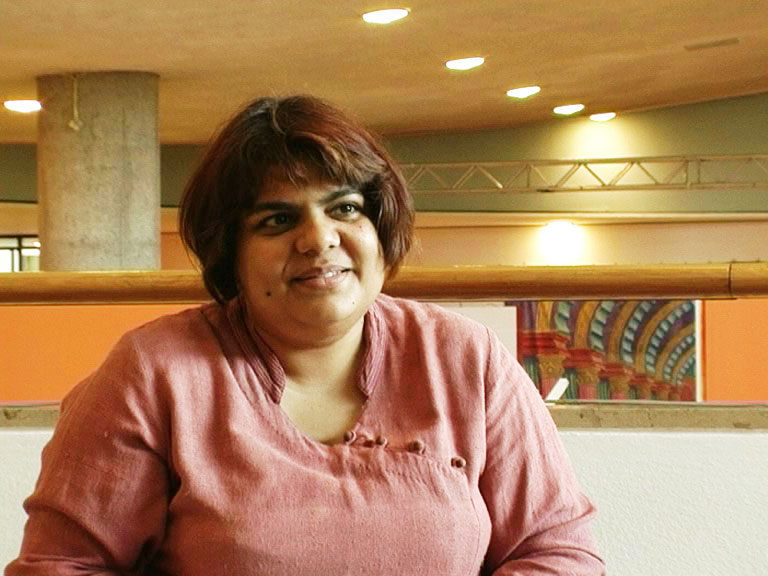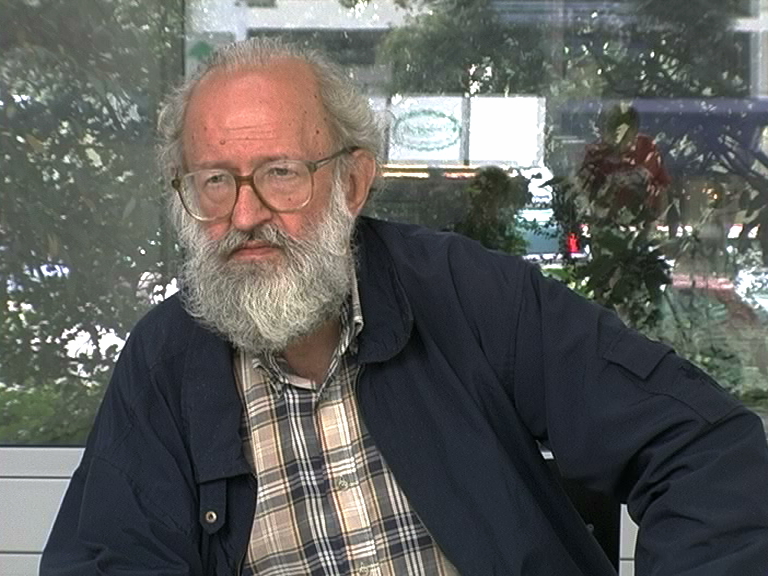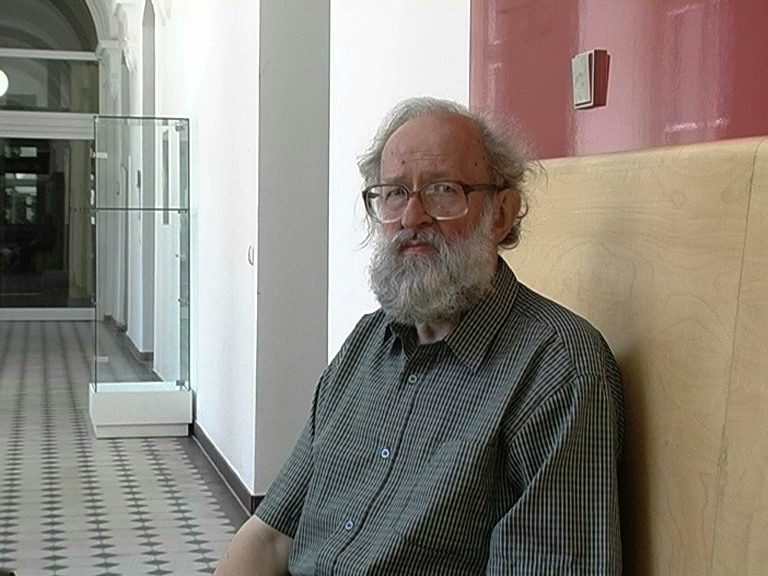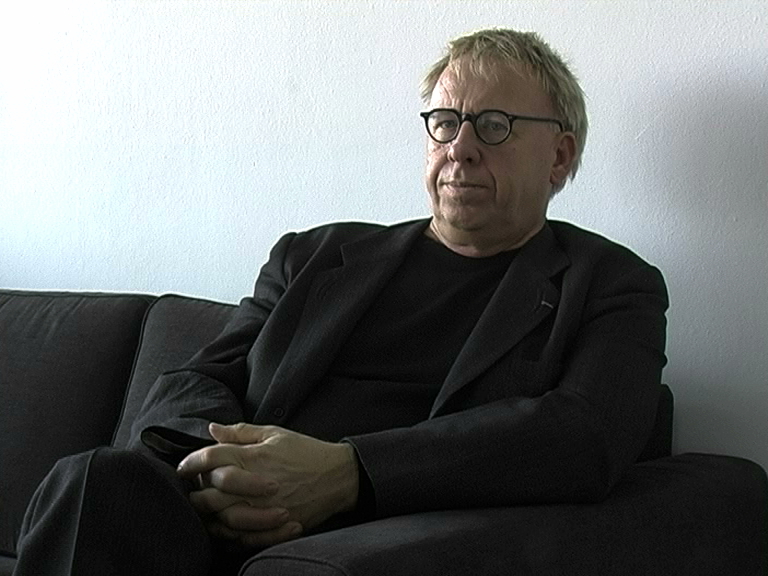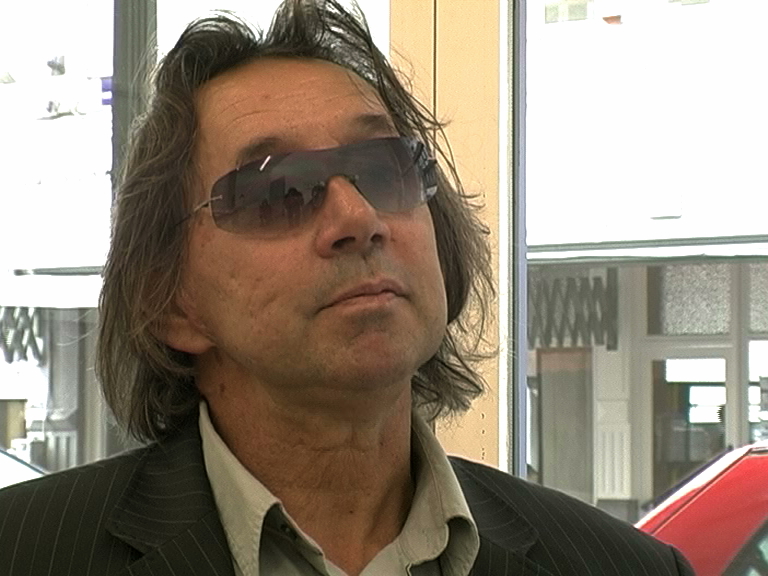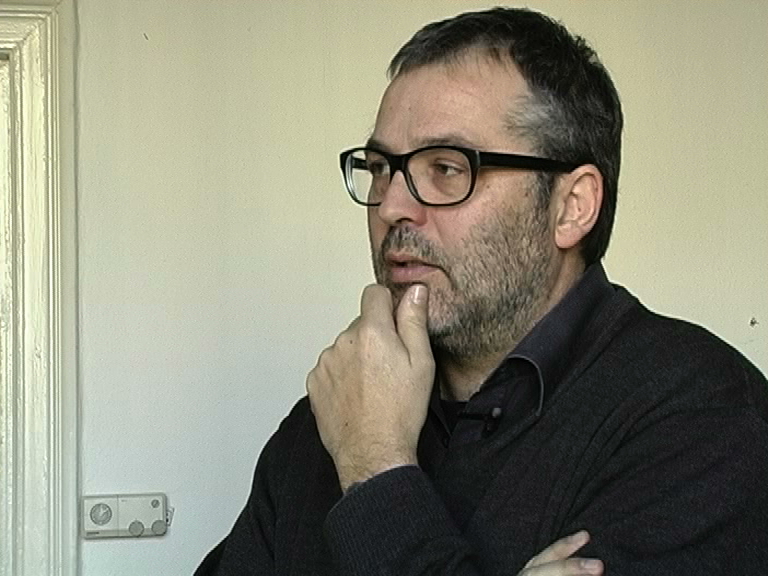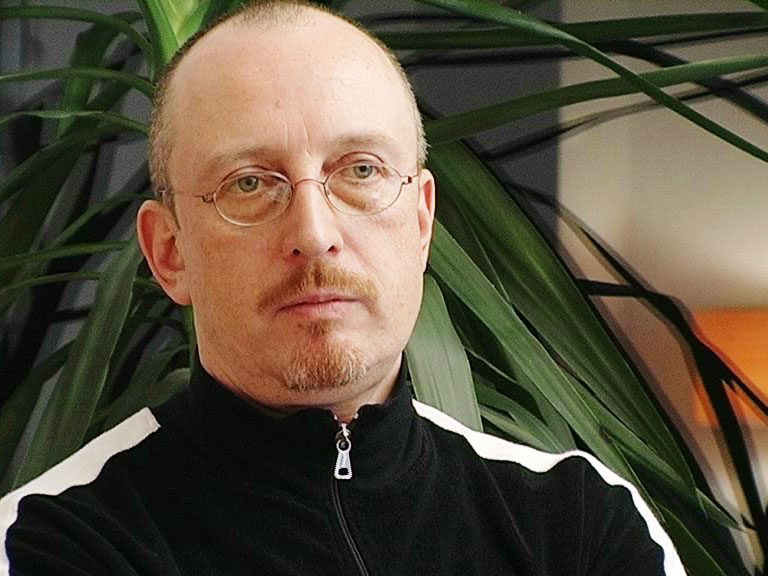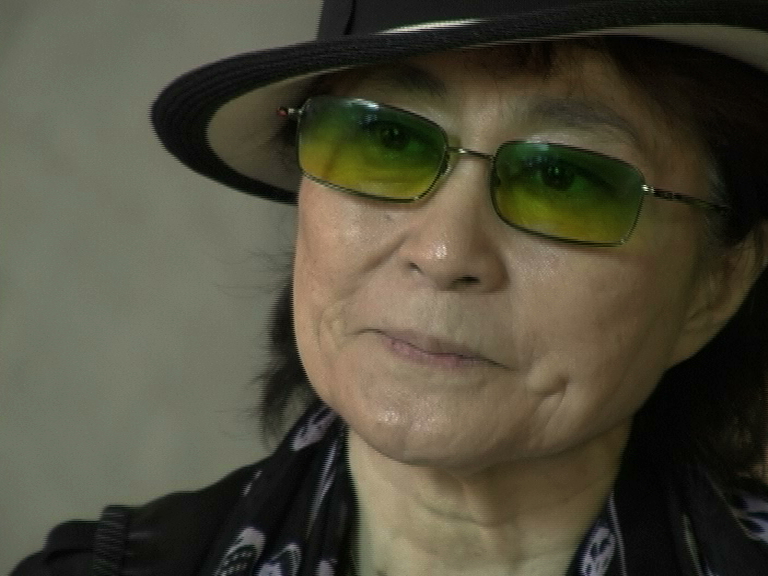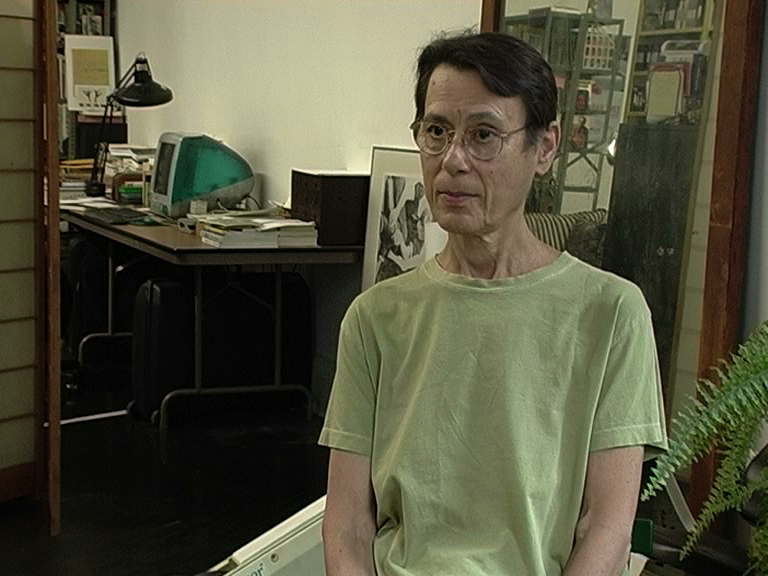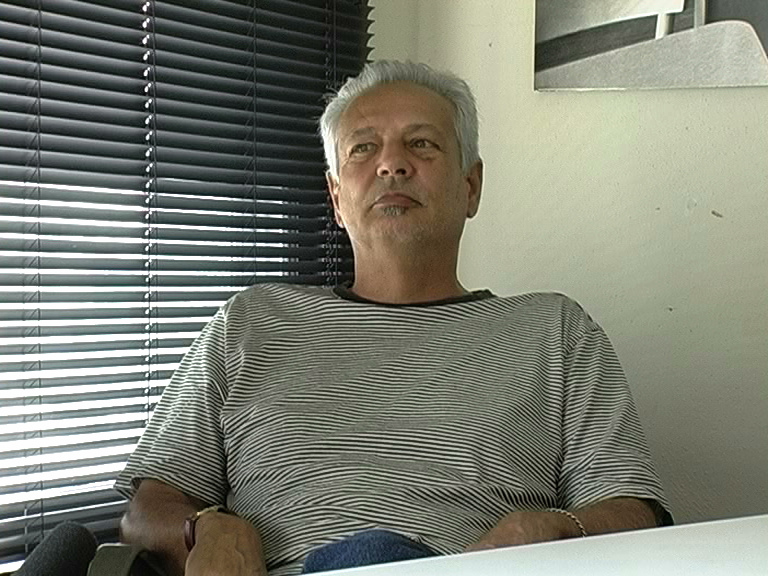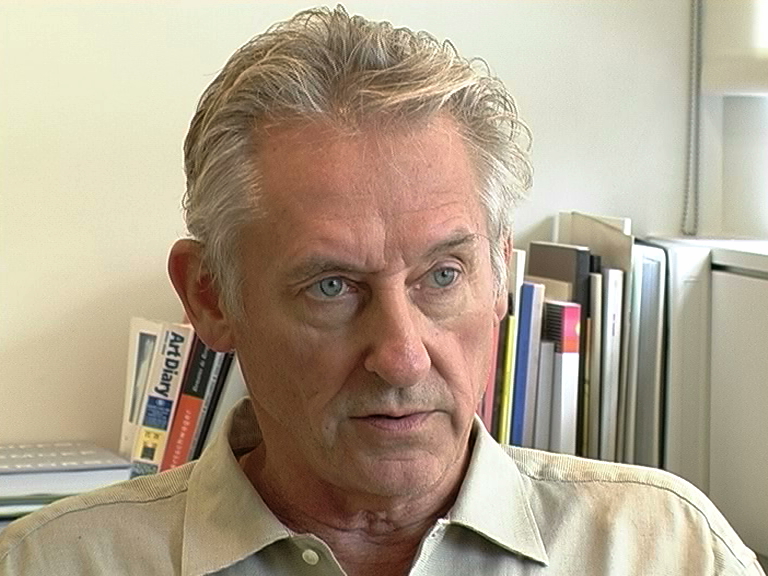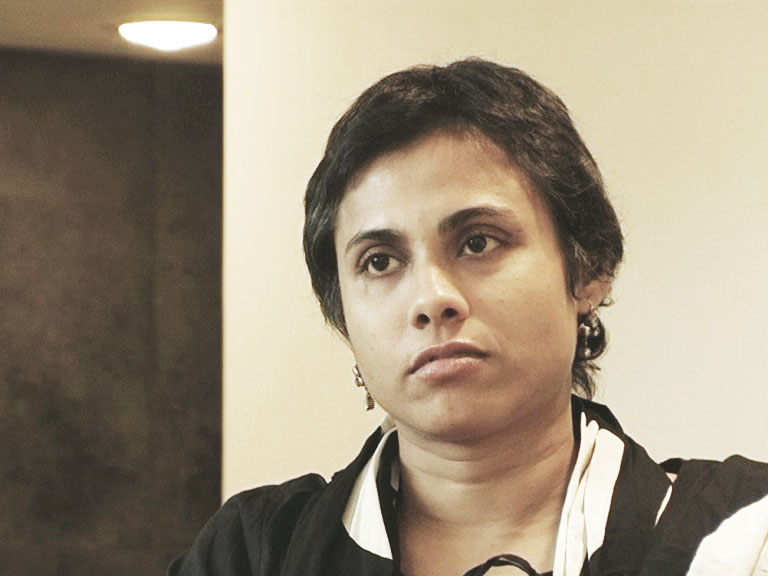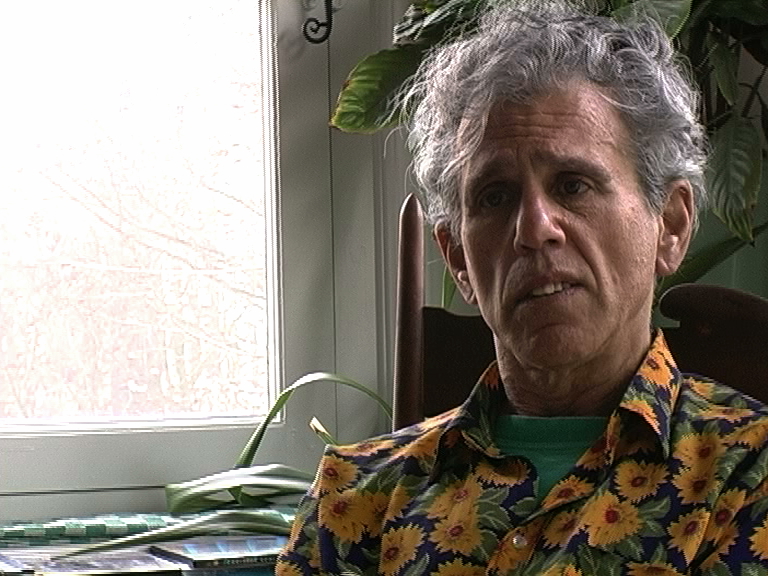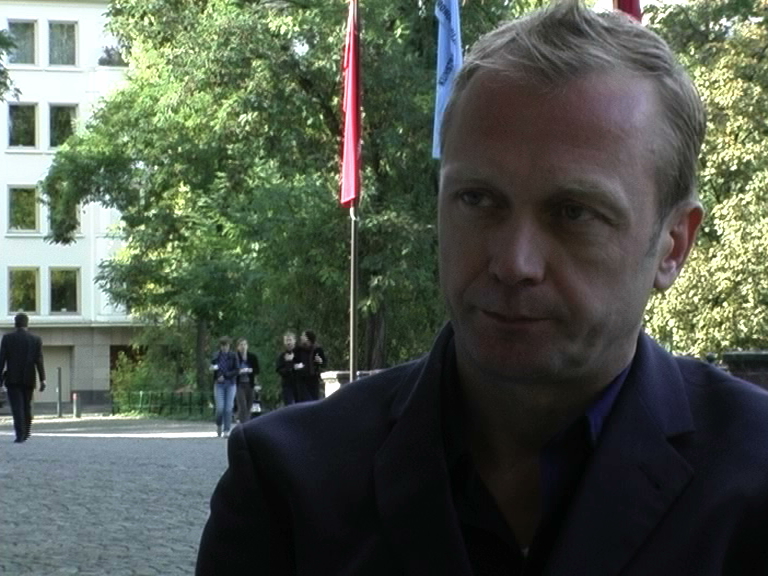S.R.: One term that seems to be very important for your work, I saw it in some different texts, is the term of “visual environment”, means envirinments that get visualized. Do you want to say something how you started to work with this approach?
L.G.: It’s very important to understand that this attention to the way you describe the territories that you are dealing with, and the culture, are very crucial for me. It’s partly to, one of the legacies of, you could call it Conceptual art or you could also call it a kind of critical speeding-up of the engagement between artist and society with an increased consciousness of what you describe as your territory for playing with. So the idea of a visual environment for me is much broader than the notion of the artist in relation to something. It makes the artist appear to be also an implicated player within the society. Not somebody who is. It’s a very kind of subtle thing but the terminology is very precise. It tries to unlimit the potential territories to play with and it tries to also, in a classical way, to de-aesthetisize, in an old-fashioned idea of aesthetitics, the places where you are allowed, you have permition to investigate. It’s also a kind of generalization which is not, which will do a kind of looking at it. It allows you to have a broad territory to play within, and that’s what crucial for me.
S.R.: Exactly that, I think exactly that was the interesting point for me to ask you to do this interview because I have a quotation about your work that characterizes this kind of view, this complex kind of working practice: “Gillick‘s more conceptual based projects are refreshingly destined from the expressive sensationalism which characteristic among his contemporaries.” It‘s a kind of rhetoric that puts you in a 90s art-movement of British art but in the same way it characterizes you and your work, it characterizes a difference.
L.G.: But one of the key differences is, a lot of the things I do they are not based on irony. I don’t mean irony in a kind of homorous way, but I mean the fact that the work is not based on an ironic acknowledgement of the failure of modernism, if you like. So you could argue that a lot of very simplistic anglosaxon post-modernism is based on a simple understanding of post-modernism as an ironic understanding of the failure of modernism. So what’s also interesting is although that quote mentions the idea of expression and things like this. It’s also true that I don’t think that the work I’ve done has ever been a pure appropriation of say earlier conceptual strategies where you merely appropriate and turn, and make an earlier conceptual strategy more everyday or more straightforward in the manner of an artist like Jonathan Monk and Martin Creed or some of these other people that have come out of Britain. Where it’s much clearer that they take the total framework of an earlier conceptual project and merely replace the content. And through that replacing of the content you have a “You know that I know that you know” kind of process taking place. And then with other people that came out of this British context there is more of a psychological play. On one simplistic level you could argue that the work of Douglas Gordon often is a kind of taking the bones of earlier influences like James Coleman but adding this kind of slightly insidious psychological, destabilizing element that sort of undermines the more critical theory-aspects of that earlier work. Now I’m in a slightly different position partly because a lot of the basic, my starting position was one of a combination of distraction and delusion. So I needed to find ways to work that were not fixed in terms of certain understandings of what art should be. So my sense of my ironic relationship to modernism, or late moderism. I was never really convinced that, I needed to test it, I need to test how do we know this is the case. A good example of that would be the very early work I did with Henri Bond. Were we‘d been through an education environment where we were told that we live in a totally relativistic society where everything is available to every artist to do whatever they want. And all certainties are over and all collective strategies are off, and everything is open for question. And as a part of that images become unstable, and then meaning becomes unstable and so on. What we were very curious about is if we assume this to be a position that you can’t tell the difference between one thing and another. How do things still get decided, how are politics strategized. How the things become powerful, how things still progress they seem to, but how might this be. And so a lot of our work was about going back to this idea of research. So a lot of work, a lot of work of my own work ended up more about this idea of pre-production and post-production rather than the idea of the bit in the middle that reinforces a kind of post-modern truism, do you see what I mean. There was very little point for me in doing that from an ironic perspective, like ironic researching. There seemed so much territory that still could be investigated and played with. It didn’t seem time to be ironic about it. On the other hand I wouldn’t say that the work or my position was really either coming from a complete, a very pure legacy of critical theory in the way that Fareed Armaly or some of the other artists around Nagel Gallery in the early 90s were really trying to adress the idea of transparcency within the work, the idea of the documentary strategy. So in a way, it means that my position was always a little bit more meandering, you see what I mean. A lot of stops and starts, a lot of changing of, sidestepping, and trying to make multiple entry-points into the idea of the work. So, trying to change the question from what is the idea behind your work. Or to finding new, multiple entry-points that people could have into any given kind of matrix of starting points. It’s kind of hard to get a grip on it but it’s crucial to understanding my position.
S.R.: I resume that your totally widespread practice––like it is written that you are a designer, critic, curator, author, producer of things––is a result of this approach. Do you developed it out of it or did you start with a whole spectrum of practices?
L.G.: I think some of this is a question of this idea of cultural permission, meaning the people that influenced you, the strategies that influenced you. I think that while some of the people I talked to quite a lot the past fifteen years like Lawrence Weiner, for them it was often very important to create a protective umbrella, rhetorically, which could project into the future, under which they could work and be protected yet still deal with many issues within the society. I was much more influenced by the developments in social theory that you could argue, a less in a classical historical sense of view. That is more secondary to the main thrust of late modernist practice. But you know this question of design for example is not my interest was never in the idea of taking on the role of someoneelse. So the idea of the community of design; it was to do with adressing aspects within the visual environment that tradtionally had been gendered, been seen as not a serious kind of thing for an artist to adress. And these histories were relatively recent, and they were playing out, even while I was at artschool. There would be a very strong feminist group that would be powerfully attempting to critique work that was being made in a way that you don’t get the same groupings now. Even at that point in the mid 80s, tutors and teachers and lecturers would use terms like designy or decorative as negative critiques. So my interest in design comes from a desire to try to be involved in an area which I was always turned away from and told it was not serious. Yet it affects so much about what we do. The idea of ignoring it seems crazy to me. Now in the light of the 90s this seems like normal. For me it was an ideological decision. It has to do with an issue about claiming territories. And as an artist of a certain background in a certain kind of about making it my business to complicate the things that I’m allowed to play with. And that is a very significant difference from the idea of saying, it‘s not the same like saying, an artist is just like another person alongside these other people who can work in this collective community of designers and artists and musicians. I was never really part of that thinking. But it‘s much more to do with, I have never claimed those positions, you see what I mean. I happen to have used some of those strategies within my work, very instructive things. When I did the Turner Prize in Britain a couple of years ago there was one big formalistic structure in the ceiling. But I also displayed a lot of this work that I see as equally important which has to do with me. Like designing a logo for an exhibition, working on new entry-phone-systems for public houses in Brussels or doing a book-design instead of putting a work into a show and these kind of things. Almost all of this work was completely ignored in the mainstream press. It was as if it wasn’t there. It became absent because it didn’t fit the story of the idea of the artist. And that reminded me even further how important it is for me to make the borders of the activity fluid and to continue this process of looking at these territories which are just alongside art… I’m very interested in these kinds of closely related border areas.
S.R.: Do you think that it is a misunderstanding when you are associated with minimalist-inspired structures or do you think it’s just one perspective?
L.G.: It’s very difficult. Quite a long time ago Marga Eleven in Los Angeles put piece of my work in a show of like really classic minimalist art, Carl Andre, Donald Judd and so on. And of course the work doesn’t work in relation to that work. It looks so alien. You’d actually be better off doing sth. more extreme in relation to the work and sth. much more separate. I’m interested in the legacy of utopian modernism and that’s much more of an influence on me than minimal art per se. I’m interested in the applied work to do with architecture and social urbanism and the details of the renovated social space, much more interested in that than in Donald Judd, e.g. But of course there is a lot of shared DNA between those things. And so it just becomes a question of having to delaminate the reference points. It’s something that I don’t mind if the interpretation happens as a kind of accident. But it’s something that I’m constantly playing with, constantly trying to negotiate my position in relation to that. That was a very fudgy answer.
S.R.: We can do it again.
L.G.: It’s the true answer. It would appear that there is some quite precise connection with minimal art but in fact it really isn’t because it doesn’t have any of the same interests in a way. But strangely enough it does appear similar some times. I have to say that I’m not completely against what that then produces sometimes. It gives me opportunities to work in ways into situations that otherwise I wouldn’t have. That sounds wrong, too. But it’s something that I’m very conscious of, it’s that kind of play.
S.R.: When I want to draw a connection between minimalism and your work, maybe there is a connection point that is very strong but it’s a different interpretation. Because when the minimalist were very strongly interested in a process of democratization of the art object, to have similar experience of the object in the space. And they wanted to break with traditional forms of reception of sculpture and art in the artistic space. I think to that point it’s very strongly related to your installations, your environments. And there is another point you quoted Siegelaub’s statement in a text where you wrote: ”It is more important to send artists to exhibitions than to send art.”
L.G.: Absolutely, but that‘s the kind of, you could argue that Seth always said something in the end. But it’s a kind of pioneering statement, it’s a slightly hybristic kind of rhetoric, but I still believe in the principle of it. However it’s quite clear from the way I’ve worked that I also believe that the research quality of what an artist does or the concrete presence of a physical intervention is sometimes socially crucial. Partly because I’ve watched the manipulations of the cultural field by people whose interests are not progressive, and there’s been an embracing of neo-conceptual strategies by neo-liberal consensus, especially the more sophisticated side of it. Which makes it very very difficult to completely go along with that kind of statement. You have to constantly revise your position in order to compete with the anarchy of capitalism and the kind of chaotic opportunism of those structures. A few years ago I was invited to come to an advisory panel of the City of Westminster in London which is traditionally, one of these classic political structures; where it’s politically right-wing but socially, artistically and culturally liberal because it’s London. Therefore you have this problem that they do quite socially destructive things. Yet they support the arts, culture. And they were very excited because they were coming up with a new art-strategy for the city. Historically they’ve been obliged to do certain things that leave a physical mark on the city, a record of some action that’s different from our everyday experience. Now they’d become very excited about the fact that they had realized that people were doing once again their work was dematerializing more and more. And they were excited about the possibility that they could stop fulfilling their concrete physical obligation, to conrectely and physically show cultural and artistic intervention into the city and they could replace it by projects, documentaries, temporary things, conceptual works. And they had thought that I would be very excited about this. Of course to a certain extent it seems superficially a very progressive position but in fact what they were trying to do was to make sure the streets and the public spaces were cleared of any physical evidence, so that it could become a free zone for their continued partnerships with corporate interests. That’s why these things become very complicated for me, and that’s why there was a clear decision I made in 1995 that the way I work doesn’t really carry the same the physical nature of the things that sometimes get produced to go alongside all the other things I’m interested in. It is significant what they are and how they are made and how they look and where they are. There was a point up to about 1995, before I didn’t care, I improvised almost entirely, and I didn’t mind who made the work, didn‘t matter. And it was only when I came into contact with a large, friendly, complicated corporate environment that I realized I had to change because I had given them the trust, I had trusted them to execute work on my behalf. And ironically, this is the strange thing. They had over-executed it, they over-determined it, it even more art-like than I had ever intended it to be, and that’s when I realized that these fine lines that I try to get within the work in these negotiated positions are significant in themselves and they are important and crucial to the work. And it’s not just a question of: here‘s the basic idea and you do it for me. It doesn’t always work; things are more complicated than that. And I realised that you can date it to June 1995. I became more interested in planning. In this kind of rhetorical game that you play with yourself in this whole sort of inner dialogue you‘re always having, that I realized that some of the tensions historically that I was interested in were not necessarily the big broadly written arguments between, say, left and right or nationalism and internationalism but were more subtle to do with questions like the battle between planning and speculation. And I realized that the way I had been working to that point had only ever embraced what you could call a speculative model. If you go only improvize you can have some nice warm and friendly, fuzzy nostalgia to the idea of improvisation as a better way to do things which but is connected to a rather 1950s idea of expression. I realized I was actually potentially more interested in planning. The more morally and ethically complicated and difficult thing to do would be to try and adress the question of planning. So there is a sudden change in the work where I started to pre-consider, to check, to research more, to apply the research to a situation and not just go and improvize. That’s the dilemma within classical Conceptual art too. There’s a constant subplot to all of it about the execution of the work despite everything. And I think not necessarily interesting to a broader public. But it’s like one of those internal struggles, what you get, when you want to change something or do something. It’s about methods and image and which direction to go in. That was definitely a key, this shift to trying to adress the question of planning––intention in relation to this idea of speculation. When you look at Berlin you can say that speculation won. You look at the city that was planned in two halfes, now speculation won. This has very strong social effects. That’s been the case also in Britain for various reasons. These are the things that exercise me. When you see things in the work that appear to be like design often what they are really adressing are these other kind of auto-focus issues: renovation, speculation, compromise, strategy. They are not pictures of it but their environments where you might find a kind of non-space we could start to re-consider some of these ideas, at best. (laughs)
S.R.: That fits very well as a specific introduction to your work… Now we can switch to the second part of the questions which are much more abstract. I Will ask you about the communicative relationships to the history of art. What do you consider as your strongest influence not only from art?
L.G.: There’s two clear things. One is this kind of notional hut? in the sense of a community of thinkers, people thinking and working doing something. It’s just that sense that you have in any given moment. This is a very strong influence on me. The idea that you are involved in an interplay that is often unspoken but there are moments of coming together. This sound very simple. The other one is the sense of the built world. This kind of, this constant adjustment of the built world and this constant play with posession and repossession and planning, strategy, speculation, movement and so on. E.g. here, next to the UN I spend a lot of time watching how they re-arrange the flow in the street and the movement of people and the control systems and the barriers and the baricades and temporary structures that come and go in order to, both literally and psychology, show security as an idea. Or to exclude or not exclude it. The kind of things that influence me on a daily basis watching the removal of the fence around the UN. It’s been there for 15 years. The same one but with deeper foundation. The removal of something, the replacement of it with its double yet with a kind of under-foundation that is three times a s big. This kind of thing is what’s affecting me.
S.R.: Do you want to focus a little bit on the history of art? Can you name some artists or practices which had a strong influence?
L.G.: It breaks down into three categories: one is people where I understand the starting point but where I don’t understand where they get to. It‘s quite strong for me. One is people where what their understanding of the social function of art, the behaviour, the way they deal with the world and their position is very strongly influential. And the other one would be where I feel that there is a kind of ongoing depth to the work where––this sounds very old fashioned or rather romantic––I can keep coming back to things––it sounds incredibly neo-conservative. But it tends to be not with, I don‘t think they are neo-conservative artists. A good example of the first one might be Kai Althoff. I think I kind of understand where he comes from but I have no idea quite how he ends up with what he’s ending up with. It’s quite alien to me but there is sth. I appreciate quite a lot about it. A good example of the second one would be Lawrence Weiner and a good example of the third one would be James Coleman. However, none of these people directly influenced the work. Some very strange, Douglas Huebler, I was very interested in his work when I was at artschool. But I find it almost completely useless as a reference point. I don’t find it useful for anything I do. On the other hand there are other artists who were quite influential on what I do, physically and literally in the space. I always thought if someone just worked it out and made the connection, that they would certainly find a lot of things. Kippenberger was incredibly influential on me as an artist but people don’t think they can see that. But if you think about it and look at the work, and especially with this recent exhibition where there’s more architectural reference points within the work which I think it‘s been in Bordeaux, which I havn‘t seen, but I am aware of. There is something there, it‘s not exacly an influence but some kind of attitudinal to a certain extent and not about persona or behaviour or anything like that but to do with the idea of––maybe it’s entirely formless––it’s to do with how you can take thinks and reconfigure them. Somewhere in the work there is a little bit of that definitely, surprisingly enough. But he was incredibly influential on Britain and very that whole period in Cologne was very influential because it became a model of how you could do an art center in a place that wasn’t NY or Paris. The idea of Cologne as it where in the 80s became a model for a lot of people at Goldsmiths. Even though they wouldn’t talk about it or couldn‘t nessecarily. Of course you see this much more clearly in some other peoples work like Sarah Lucas and so on. There was sth. about that kind of modelling of a decentered centre for art exchange that was very influential. That’s a kind of honest anwer, slightly disturbing one, maybe.
S.R.: Coming with another question that you’ve already touched. What is your aim, or goal with your practice?
L.G.: To a certain extent it has this research-component, that like someone working in physics––things that have been discussed historically, the idea of the audience for art is about the same as the audience for theoretical physics. In fact it’s much broader than, it‘s much bigger for theoretical physics now. But to a certain extent I view it like that, it’s a research activity alongside many others, often more relevant than many others. I do strongly believe in this rather possibly simplistic idea that an art education, in fact for everyone, is incredibly important. You see this in a lot of the things that surround us. Even the issue in the last election about how to design of a ballot paper, a voting paper being not thought through––that’s a direct result of there being a very bad art education. You wouldn’t get bad ballot papers if you had a serious art education. So I do, part of it is a general belief in the idea of art or aesthetic consideration, thinking about the visual environment being very important, and me just being a rather introverted version of it. That‘s definitely one part of it. I think that’s about it. I‘m not very hard thinking about, I am very sceptical about the potential, you know I have a very fragmented, I don’t have a very precise kind of position about in terms of a singular position. So a lot of it is kind of negotiated. You know the moment I’m working a lot in the United Stated, so I’m having to re-assess a lot of my thinking about things because I’m often alone. Suddenly I’ve gone from a semi-collective environment, where I’m often with other artists and other people, to often being alone. You go somewhere and you are allone, you are invited alone. There is a strong cultural pressure to be alone. The people who support culture in America, when they support the idea of a museum or an art center inviting an artist, they want the artist. They don’t want lots of artists at the same time, it’s too complicated. I’m having to constantly re-assess what I think about that and how I might be prepared to proceed. The other thing––it is very important to talk about––these semi-public, semi-private projects that I get involved in, like Kunst-am-Bau projects in a way. But some of them are a bit more, they go from one extreme to the other. Some of them are very socially oriented, some of them are entirely private. This for me is incredibly important. And it’s a dangerous territory because to a certain extent it has the illusion that you can be an interventionist. It‘s the classic sort of nuclear, brought up in the age of kind of nuclear fear, like myself, often believed. Or used the psychological trick as a child, of the idea to become an interventionist, to get inside the system, and it‘s a kind of spirit of the inside. So that when it came to the crunch you could shut everything down. A lot of people from Western Europe who brought up in the 60s, 70s and even the 80s grew up with this feeling that, maybe it was worth kind of intervening at some level with this kind of complicated world, powerful world to see if you could intervene. I’m not sure if it’s possible but I’m playing some of these games and sometimes it’s getting very close to not really working. So I have to see. This is the question I’m currently asking, it‘s about how close the artist can come to this moment of intervening, this kind of dialogue in power structures. When you are working doing projects for governments, for cities, for big law firms and for corporations you are sitting with directors , with politicians, with this people, that‘s what you do at that point. And of course they already have an inbuilt sense of what art signifies or means. So that they actally, I’m suddenly for the first time having to adress this idea of what other people think artists represent within the culture, and it’s a very complicated and new territory for me to play with, I‘m not sure. They told me a good anecdote which might be symbolic of this, when I was discussing this with some people about the project that I’m working on here. The last project they worked on was with a conceptual, what you would think of as a classic conceptual artist. And they said that in all of the meetings he didn’t speak, and maybe I sometimes do it the other way round too much, I only speak. You couldn’t get a better picture of two related yet different strategies: The person who thinks, it’s not for me to speak, you are already wrong, it’s already clear; and then my feeling that there might be some way to negotiate this corporate and cultural sphere. In some way I’m trying not just let the work speak for itself as it where. Because I’m not convinced that that is in itself a strong critical position. Just to say, I don’t speak, this is the work, you take it and you deal with it. And the work itself would be an inherent critique. I’m not so convinced that that’s always the case. I think I have to be an inherent critique too sometimes.
S.R.: My next question: Do you think that the so called conceptual paradigms are still in function? Are there possibilities to renew them or would this be the opposite of a post-modern understanding?
L.G.: Well I think that already very early on a lot of people critiqued the classic Northamerican Conceptual art-practice, especially the people around Art & Language who would say that this was often just the taking and nominating of things in the world, it was a form of cultural imperialism in a way, a lazy form of the same thing, you know. And I have some sympathy with that kind of position in a way, however I don’t quite go along with the idea that, I don’t think that the project as it were of socially conscious critical practice goes away. I mean it never really went away. It’s under attack all the time from conservative forces and it can be absorbed and used and played with by people for many reasons and has to reinventing itself. But then again these were all kaind of clichées in themselves. It‘s a vers difficult thing to talk about because I don‘t feel the… One way of looking at it might be to argue––here’s kind of a cinematic sort of argument––to look at wether or not something is, a lot of things, I’m interested in whether or not something I’m involved in is documentary of fiction. And it’s often a better way to look at it than the way of looking at it in terms of what appears to be there, ot what it appears to be about the starting point, or what it seems to be critiquing. In a general approach it’s often this question of documentary and fiction, and you could certainly say that within the last few years there’s been an enormous rise in a kind of documentary-orientated art practice which––as happens in all times of a kind of financial boom––is working away and producing very interesting things almost completely ignored by this dynamic oriented art market. Right now you have a classic situation where you have absolute polarization of documentary and fiction. You have a lot of fiction, on one hand the work of John Curren, Lucia ?, many of the new ironic Eastgerman realist painters. And then you have this documentary work. It‘s very polarized. And I think People are taking very polarizing positions. My work often has something of the two. It plays a lot with the documentary and fiction sort of idea. To a certain extent I see a lot of the legacy of conceptual practice within this documentary tendency. One of the other crucial things is that we cant‘ look at art in isolation. Obviously again this is a truisms, but I mean in terms of the changes within curating and also one of the things that doesn’t get talked about very much, which is young art historians who are coming up… with new critical positions. One of the arguments I’m having right now a lot is about whether a version of this Utopia Station project from Venice should go to the World Social Forum in Puerto Allegre. And to a certain extent I was arguing strongly that, from an artist’s position, I don’t think it’s a very interesting thing to do. I don’t think it’s productive, it’s coquettish, even dilettantish to go there. But from a curating position it’s quite interesting and I can see why the curatorial team wants to go and take the Utopia Station-project to the Social Forum in Porto Alegre because it’s not that uninteresting from a curatorial standpoint. I don’t see why they can’t just do that autonomously. I’m rather interested in these kinds of semi-autonomous fragmentings and shatterings of things. I don’t see why you can’t have just an semi-autonomous critical and curatorial position that is informed by recent art history thinking. And people who are disappointed with art history and go into a more dynamic area who are also creating valid and valuable positions that are equally valued to otherones. I think these things are all the legacy of the moment in art when people decided to speed things up––which is what I also think happend with high-end Conceptual art. It’s a speeding-up of things, an acceleration of what you are dealing with and how you are adressing things. It’s a speeding-up of art in relation to society, to cover a lot of territory. There are big political obligations now to adress the documentary functions of art but also not necessarily, not to underestimate certain critical and curatorial positions as semi-autonomous. But I can‘t get and just, I think it would be quite interesting for the curators to go on their own. It’s very difficult, but it’s a very interesting test case because the discussions around it have been happening with Hans Haacke, Larence Weiner, Martha Rosler, myself, Pierre Huyghe, a couple of other people, Anton Vidokle. And they are quite fraught discussions and not at all easy, whether to go, whether not to go; to send someone else; whether everyone should go, maybe all artists should go, maybe the whole thing is a joke. Maybe the whole thing is a kind of neo-liberal trick to get everyone who has a tiny grievance in the world, to all go somewhere––relatively in power-structural terms––in the middle of nowhere in a kind of oldschool perspective and argue about it there. There’s a lot of tension. And I think this is a way that the legacy of Conceptual art can be interesting and valid which is to do with this kind of questions. The fear you can negotiate of this kind of questions and make the negotiation of this kind of questions central to your work. That can be the work, that can be the thing that’s happening. And that is an incredibly important legacy. And, of course, denying legacies as such can also be an important one. When you look at the programming of institutions––what gets done, what get‘s seen, what get‘s bought by the big museums, when you look at the gender-split of major shows and major museums. When you look at all this things you can see the critical processes that started in 68––you could argue politically, and then continued and then came under incredible backlash-pressure in the 70s and 80s especially in the Anglosaxon world––there are still battles to be fought. Some artists do it with a soft touch and their rhetoric is a bit softer than others‘ but these processes are still crucial. I mean they are still underway.
S.R.: Hans Haacke was talking to us about Utopia Station. He is not able to think of it. Because he said, his argument was, that he is so much involved in what he calls reality or the daily life or what he feels he is into that he is not even able to think what could be something like Utopia. It was typically Hans Haacke. I know him for a long time. And I like his kind of laconic, pragmatic putting the things. Because he is always so pragmatically bound with the situation.
L.G.: Ya, but, I agree, this is, I actually agree with him about this.
I mean too some extent I’m absolutely instinctively, I have a lot of sympathy for this kind of position. But then again I’m concerned about the legacy of straight white men sitting around and say, I’m not going to do anything until everyone gets together and does it together. I’m much more influenced by the legacy of revised social practice. I have an element of scepsis and about his position, too. But I mean this was a discoursive process. I hate this word Utopia too; it was used by the Right as an accusation against any form of progressive practice in Britain. And certainly the history of post-war reconstruction in terms of ideologically complex and progressive social work was always critisized by the Right as utopian. It would have been a nice idea but it was a utopian idea to make good quality housing for poor people. Because they don‘t appreciate that they smash it up. So I hate the use of this word utopian. I think I have the some kind of problem with it. You know I also have, it’s difficult for me intuitively to deal with the fact that the first protests against the Republican convention here in New York tended to be from what have been called like interest groups. It seems like a divided world. Part of me is sympathetic to the––what I have called––old-school position where everyone comes together and fights for a bigger kind of collective position. But the fact is that I would say that, wouldn’t I, because of who I am, because it‘s directly that‘s been the position. It’s a difficult thing with this whole kind of utopia question. I think it’s possible that some people can be involved in this project yet absent themselves from the dynamic activity. When I was a teenager I used to go to Greenham Common in England where they had the American airbase and they had a women’s peacecamp. And I would absent myself from the direct action that was taking place. Yet be there in a supportive role. Some of these strategies could be ways around this whole problem, but the interesting thing for me is in fact this focus on what Hans Haacke thinks or what I think or anybody else thinks is not necessarily in synch with the true dynamic of the project which is actually to do with curating. It’s got very little to do with what he thinks or I think. It’s got to do with this kind of other world of curatorial dynamic which is often skirted over which is also a direct legacy of revised critical practice from the mid to late 60s onwards. It has its own specific history.
S.R.: I agree with some of your ideas but I didn’t like the––it‘s very simple––I didn’t like the presentation of it in Venice. It was the wrong place, it was wrongly positioned. I couldn’t find the works of my friends. I was running around, everybody asked each other, have you seen that…
L.G.: You are way to see it at Haus der Kunst… Yes, I agree. It has inbuilt––that was my critique from the beginning––and the point about . It has a strong discoursive component where there’s a lot of argument and a lot of discussion, and basically you have to concede sometimes. And I have pretty much lost every, I didn‘t won the arguments often. But I lost in reality because it didn’t happen. From my first speech I made in ? where I tried to change the title, change the location… I got kind of outvoted… It has inbuilt into the structure of it all the things that allowed people at a certain point… in the kind of 70s to say, well it was all very nice to have this utopian kind of modern thinking but it doesn’t work––because it has built into it all of the same problems communal thinking often has, improvised communal thinking. Opportunists can take over and there are usually two or three people who have predecided something before the discussion. All this things are built into it. As a productive discoursive environment to talk about all these things it’s very very interesting. The effects are not necessarily the most interesting thing about it. So we‘ll see.
S.R.: I have only one more question. And very easy: What is your ideal, typical daily work as an artist?
L.G.: I’m not staying focussed on anything for particularly long. So it’s to do with a lot of multiple positions. So I’m changing every 20 minutes from one thing to the other. The ideal position would be to be writing sth., planning sth., projecting sth., and communicating all on top of each other in a single period. This is the way I find the best to work, basically. But it means it’s a rather introverted practice. It’s not collective, I’m doing it on my own. It’s not very cinematic or terribly, yeah, it’s rather inward-looking I think as a way of working. And then it’s punctuated by these kind of slightly aimles wanderings around to look at the projected site for sth. which I find much less productive than this kind of mental space––I mean literally and metaphorically––this kind of mental space which I think is still. I can feel an Adorno coming on. But this idea of thinking is very powerful as a thing, can be a strong position. I mean it’s something. When that works well that’s––as they say in America––that’s the place you want to be, I think.
S.R.: Very nice closing words. Thank you very much.




